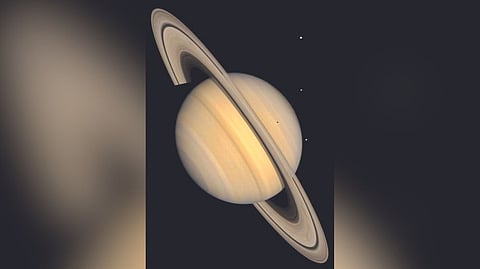

In the red corner, Jupiter, the largest planet orbiting our sun, which shaped our solar system with its gravitational bulk. In the blue corner, Saturn, the magnificent ringed world with bewildering hexagonal storms at its poles. These two giant worlds are late in their bout for satellite-based supremacy. But now the fight over which planet has the most moons in its orbit has swung decisively in Saturn’s favor. This month, the International Astronomical Union is set to recognize 62 additional moons of Saturn based on a batch of objects discovered by astronomers. The small objects will give Saturn 145 moons — eclipsing Jupiter’s total of 95.
“They both have many, many moons,” said Scott Sheppard, an astronomer from the Carnegie Institution for Science in Washington, D.C. But Saturn “appears to have significantly more,” he said, for reasons that are not entirely understood.
The newly discovered moons of Saturn are nothing like the bright object in Earth’s night sky. They are irregularly shaped, like potatoes, and no more than one or two miles across. They orbit far from the planet too, between six million and 18 million miles, compared with larger moons, like Titan, that mostly orbit within a million miles of Saturn. Yet these small irregular moons are fascinating in their own right. They are mostly clumped together in groups, and they may be remnants of larger moons that shattered while orbiting Saturn.
“These moons are pretty key to understanding some of the big questions about the solar system,” said Bonnie Buratti of NASA’s Jet Propulsion Laboratory in California and the deputy project scientist on the upcoming Europa Clipper mission to Jupiter. “They have the fingerprints of events that took place in the early solar system.” The growing number of moons also highlights potential debates over what constitutes a moon.
“The simple definition of a moon is that it’s an object that orbits a planet,” Dr. Sheppard said. An object’s size, for the moment, doesn’t matter.
The new moons were discovered by two groups, one led by Dr. Sheppard and the other more recently by Edward Ashton of the Academia Sinica Institute of Astronomy and Astrophysics in Taiwan. Dr. Sheppard’s group, in the mid-2000s, used the Subaru Telescope in Hawaii to hunt for more moons around Saturn.
In March, Dr. Sheppard was also responsible for finding 12 new moons of Jupiter, which took it temporarily above Saturn in the scuffle to be the biggest hoarder of moons. That record was short-lived, it seems. Dr. Ashton’s group, from 2019 to 2021, used the Canada France Hawaii Telescope, a neighbour of the Subaru Telescope on Mauna Kea, to look for more of Saturn’s moons and to verify some of Dr. Sheppard’s discoveries. For a moon to be authenticated, it must be spotted multiple times to “be sure the observations are a satellite and not just an asteroid that happens to be near the planet,” said Mike Alexandersen, who is responsible for officially confirming moons at the International Astronomical Union.
Most of Saturn’s irregular moons orbit the planet in what astronomers call the Inuit, Norse and Gallic groups. Each group’s objects may be the remains of larger moons, up to 150 miles across, that once orbited Saturn but were destroyed by impacts from asteroids or comets, or collisions between two moons. “It shows there’s a big collision history around these planets,” Dr. Sheppard said.
Visit news.dtnext.in to explore our interactive epaper!
Download the DT Next app for more exciting features!
Click here for iOS
Click here for Android